BTEC HND in Business: Entrepreneurship and Small Business Report
VerifiedAdded on 2020/10/23
|18
|4717
|383
Report
AI Summary
This report provides a comprehensive overview of entrepreneurship and small business management. It begins with an introduction to the concept of entrepreneurship and its role in creating wealth and innovation. The report then delves into different types of entrepreneurial ventures, including small business, large business, scalable start-up, and social entrepreneurship, defining their characteristics and relating them to different typologies of entrepreneurship like serial, lifestyle, social, and sole entrepreneurs. The report then proceeds to compare and contrast the similarities and differences between these entrepreneurial ventures across various dimensions such as objectives, exit value, leadership role, scope, and finance sources. Furthermore, the report assesses how micro and small businesses impact the economy using relevant data and statistics, highlighting their importance to the growth of the social economy. The report also explores the characteristics, traits, and skills of successful entrepreneurs, differentiating them from business managers, and examines how entrepreneurial personality reflects motivation and mindset. Finally, the report examines how background and experience can hinder or foster entrepreneurship. Overall, the report provides a detailed analysis of the key aspects of entrepreneurship and small business management, offering valuable insights into the entrepreneurial process and the factors that contribute to business success.

ENTREPRENEURSHIP AND
SMALL BUSINESS
ENTERPRISE
SMALL BUSINESS
ENTERPRISE
Paraphrase This Document
Need a fresh take? Get an instant paraphrase of this document with our AI Paraphraser
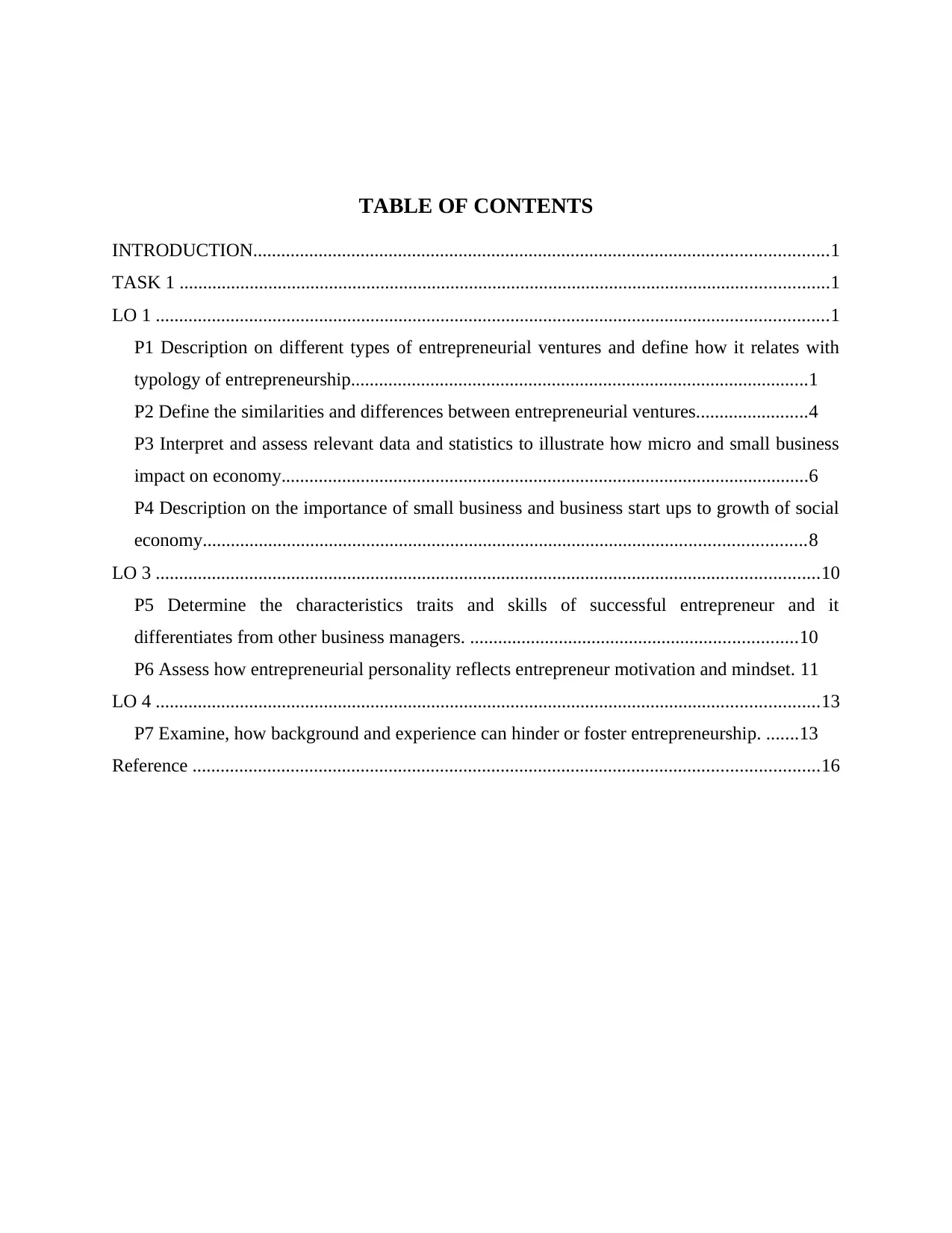
TABLE OF CONTENTS
INTRODUCTION...........................................................................................................................1
TASK 1 ...........................................................................................................................................1
LO 1 ................................................................................................................................................1
P1 Description on different types of entrepreneurial ventures and define how it relates with
typology of entrepreneurship..................................................................................................1
P2 Define the similarities and differences between entrepreneurial ventures........................4
P3 Interpret and assess relevant data and statistics to illustrate how micro and small business
impact on economy.................................................................................................................6
P4 Description on the importance of small business and business start ups to growth of social
economy.................................................................................................................................8
LO 3 ..............................................................................................................................................10
P5 Determine the characteristics traits and skills of successful entrepreneur and it
differentiates from other business managers. ......................................................................10
P6 Assess how entrepreneurial personality reflects entrepreneur motivation and mindset. 11
LO 4 ..............................................................................................................................................13
P7 Examine, how background and experience can hinder or foster entrepreneurship. .......13
Reference ......................................................................................................................................16
INTRODUCTION...........................................................................................................................1
TASK 1 ...........................................................................................................................................1
LO 1 ................................................................................................................................................1
P1 Description on different types of entrepreneurial ventures and define how it relates with
typology of entrepreneurship..................................................................................................1
P2 Define the similarities and differences between entrepreneurial ventures........................4
P3 Interpret and assess relevant data and statistics to illustrate how micro and small business
impact on economy.................................................................................................................6
P4 Description on the importance of small business and business start ups to growth of social
economy.................................................................................................................................8
LO 3 ..............................................................................................................................................10
P5 Determine the characteristics traits and skills of successful entrepreneur and it
differentiates from other business managers. ......................................................................10
P6 Assess how entrepreneurial personality reflects entrepreneur motivation and mindset. 11
LO 4 ..............................................................................................................................................13
P7 Examine, how background and experience can hinder or foster entrepreneurship. .......13
Reference ......................................................................................................................................16
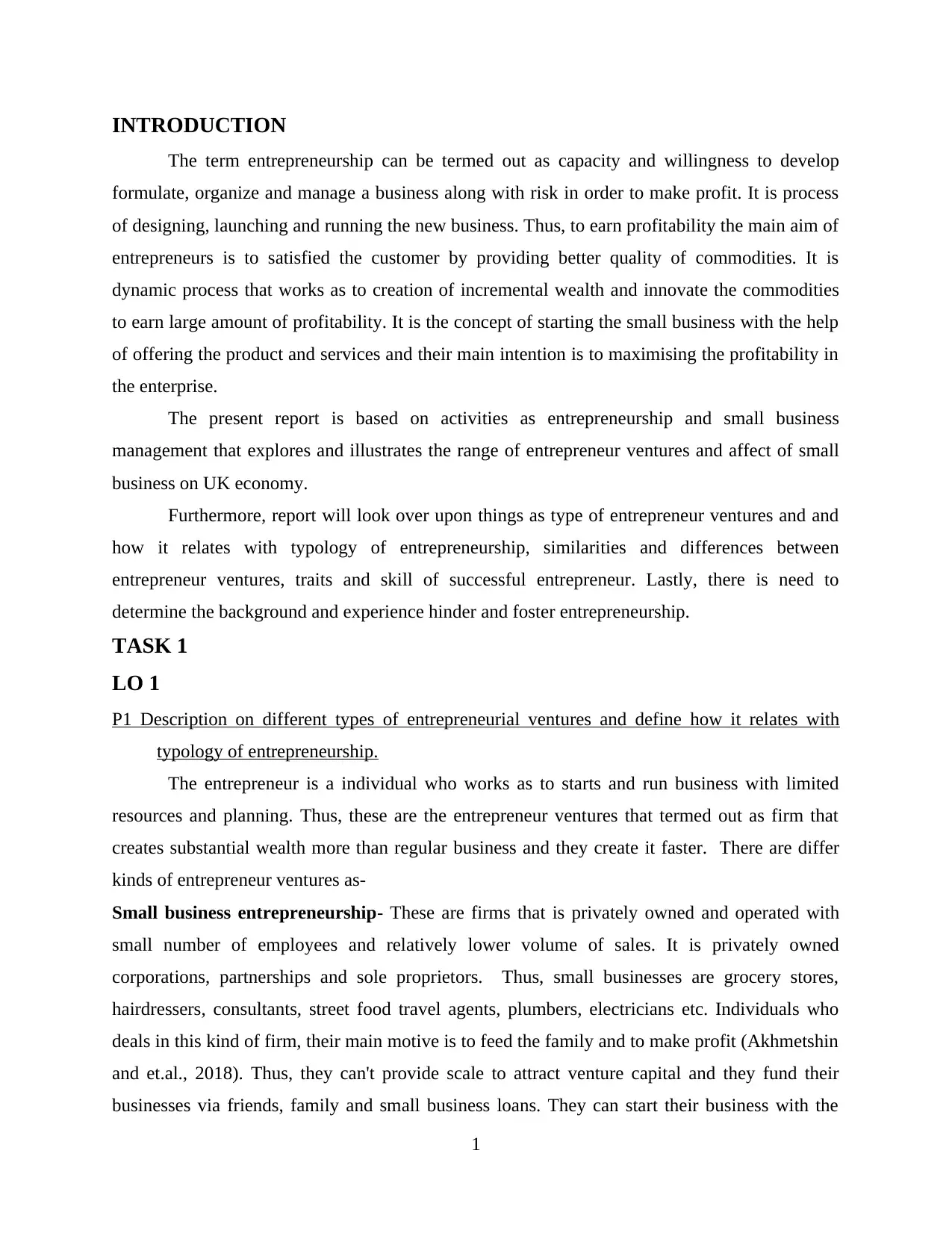
INTRODUCTION
The term entrepreneurship can be termed out as capacity and willingness to develop
formulate, organize and manage a business along with risk in order to make profit. It is process
of designing, launching and running the new business. Thus, to earn profitability the main aim of
entrepreneurs is to satisfied the customer by providing better quality of commodities. It is
dynamic process that works as to creation of incremental wealth and innovate the commodities
to earn large amount of profitability. It is the concept of starting the small business with the help
of offering the product and services and their main intention is to maximising the profitability in
the enterprise.
The present report is based on activities as entrepreneurship and small business
management that explores and illustrates the range of entrepreneur ventures and affect of small
business on UK economy.
Furthermore, report will look over upon things as type of entrepreneur ventures and and
how it relates with typology of entrepreneurship, similarities and differences between
entrepreneur ventures, traits and skill of successful entrepreneur. Lastly, there is need to
determine the background and experience hinder and foster entrepreneurship.
TASK 1
LO 1
P1 Description on different types of entrepreneurial ventures and define how it relates with
typology of entrepreneurship.
The entrepreneur is a individual who works as to starts and run business with limited
resources and planning. Thus, these are the entrepreneur ventures that termed out as firm that
creates substantial wealth more than regular business and they create it faster. There are differ
kinds of entrepreneur ventures as-
Small business entrepreneurship- These are firms that is privately owned and operated with
small number of employees and relatively lower volume of sales. It is privately owned
corporations, partnerships and sole proprietors. Thus, small businesses are grocery stores,
hairdressers, consultants, street food travel agents, plumbers, electricians etc. Individuals who
deals in this kind of firm, their main motive is to feed the family and to make profit (Akhmetshin
and et.al., 2018). Thus, they can't provide scale to attract venture capital and they fund their
businesses via friends, family and small business loans. They can start their business with the
1
The term entrepreneurship can be termed out as capacity and willingness to develop
formulate, organize and manage a business along with risk in order to make profit. It is process
of designing, launching and running the new business. Thus, to earn profitability the main aim of
entrepreneurs is to satisfied the customer by providing better quality of commodities. It is
dynamic process that works as to creation of incremental wealth and innovate the commodities
to earn large amount of profitability. It is the concept of starting the small business with the help
of offering the product and services and their main intention is to maximising the profitability in
the enterprise.
The present report is based on activities as entrepreneurship and small business
management that explores and illustrates the range of entrepreneur ventures and affect of small
business on UK economy.
Furthermore, report will look over upon things as type of entrepreneur ventures and and
how it relates with typology of entrepreneurship, similarities and differences between
entrepreneur ventures, traits and skill of successful entrepreneur. Lastly, there is need to
determine the background and experience hinder and foster entrepreneurship.
TASK 1
LO 1
P1 Description on different types of entrepreneurial ventures and define how it relates with
typology of entrepreneurship.
The entrepreneur is a individual who works as to starts and run business with limited
resources and planning. Thus, these are the entrepreneur ventures that termed out as firm that
creates substantial wealth more than regular business and they create it faster. There are differ
kinds of entrepreneur ventures as-
Small business entrepreneurship- These are firms that is privately owned and operated with
small number of employees and relatively lower volume of sales. It is privately owned
corporations, partnerships and sole proprietors. Thus, small businesses are grocery stores,
hairdressers, consultants, street food travel agents, plumbers, electricians etc. Individuals who
deals in this kind of firm, their main motive is to feed the family and to make profit (Akhmetshin
and et.al., 2018). Thus, they can't provide scale to attract venture capital and they fund their
businesses via friends, family and small business loans. They can start their business with the
1
⊘ This is a preview!⊘
Do you want full access?
Subscribe today to unlock all pages.

Trusted by 1+ million students worldwide
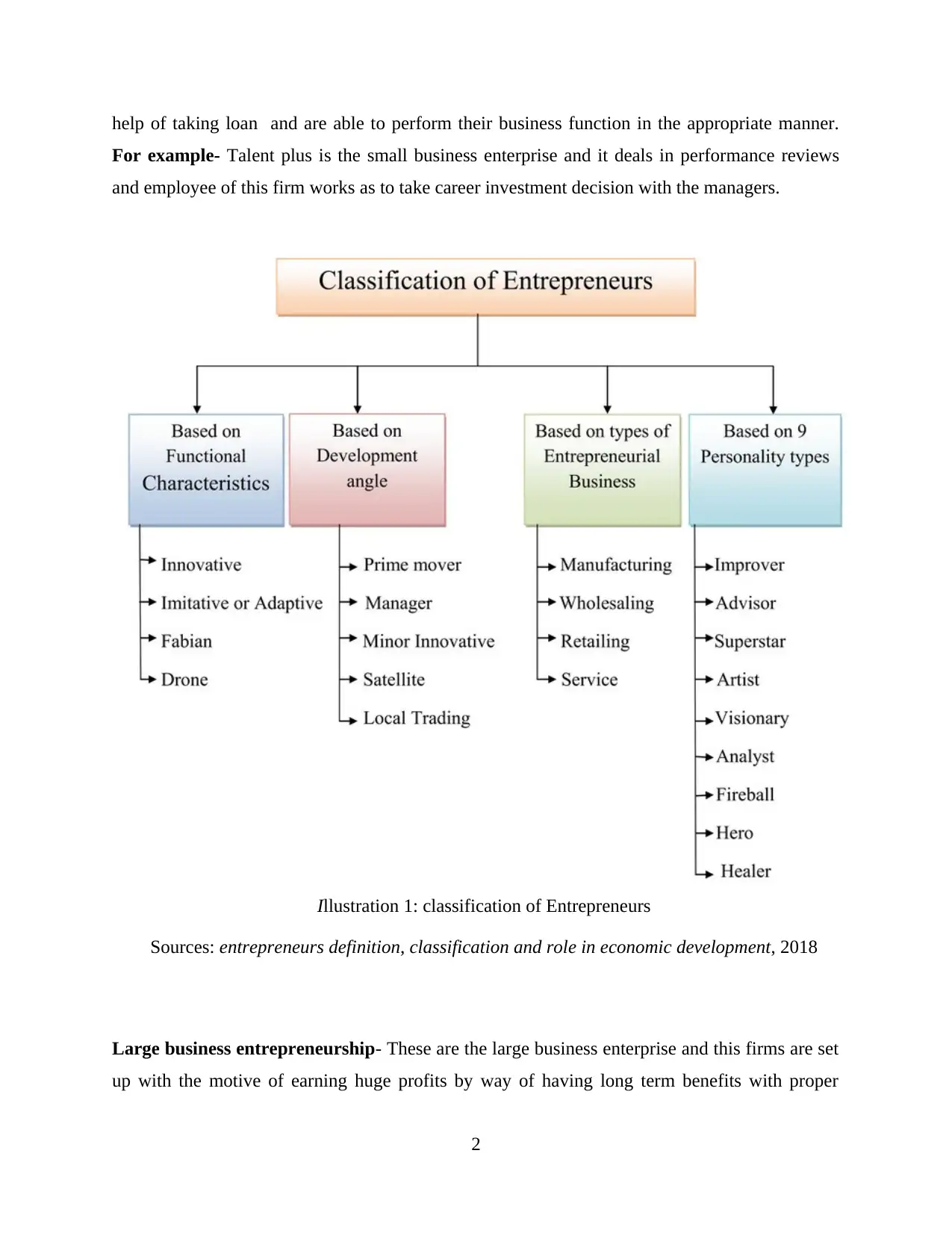
help of taking loan and are able to perform their business function in the appropriate manner.
For example- Talent plus is the small business enterprise and it deals in performance reviews
and employee of this firm works as to take career investment decision with the managers.
Large business entrepreneurship- These are the large business enterprise and this firms are set
up with the motive of earning huge profits by way of having long term benefits with proper
2
Illustration 1: classification of Entrepreneurs
Sources: entrepreneurs definition, classification and role in economic development, 2018
For example- Talent plus is the small business enterprise and it deals in performance reviews
and employee of this firm works as to take career investment decision with the managers.
Large business entrepreneurship- These are the large business enterprise and this firms are set
up with the motive of earning huge profits by way of having long term benefits with proper
2
Illustration 1: classification of Entrepreneurs
Sources: entrepreneurs definition, classification and role in economic development, 2018
Paraphrase This Document
Need a fresh take? Get an instant paraphrase of this document with our AI Paraphraser
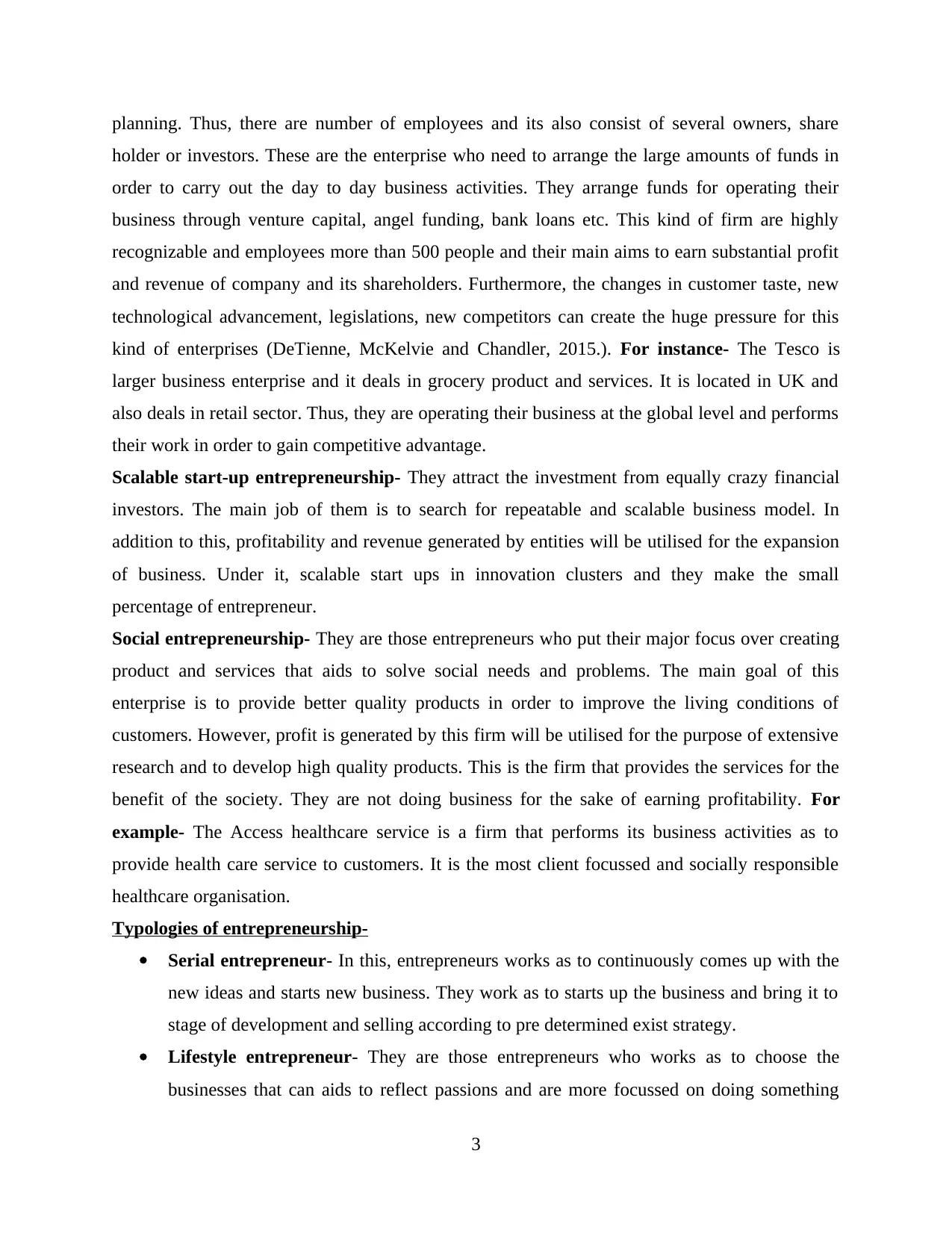
planning. Thus, there are number of employees and its also consist of several owners, share
holder or investors. These are the enterprise who need to arrange the large amounts of funds in
order to carry out the day to day business activities. They arrange funds for operating their
business through venture capital, angel funding, bank loans etc. This kind of firm are highly
recognizable and employees more than 500 people and their main aims to earn substantial profit
and revenue of company and its shareholders. Furthermore, the changes in customer taste, new
technological advancement, legislations, new competitors can create the huge pressure for this
kind of enterprises (DeTienne, McKelvie and Chandler, 2015.). For instance- The Tesco is
larger business enterprise and it deals in grocery product and services. It is located in UK and
also deals in retail sector. Thus, they are operating their business at the global level and performs
their work in order to gain competitive advantage.
Scalable start-up entrepreneurship- They attract the investment from equally crazy financial
investors. The main job of them is to search for repeatable and scalable business model. In
addition to this, profitability and revenue generated by entities will be utilised for the expansion
of business. Under it, scalable start ups in innovation clusters and they make the small
percentage of entrepreneur.
Social entrepreneurship- They are those entrepreneurs who put their major focus over creating
product and services that aids to solve social needs and problems. The main goal of this
enterprise is to provide better quality products in order to improve the living conditions of
customers. However, profit is generated by this firm will be utilised for the purpose of extensive
research and to develop high quality products. This is the firm that provides the services for the
benefit of the society. They are not doing business for the sake of earning profitability. For
example- The Access healthcare service is a firm that performs its business activities as to
provide health care service to customers. It is the most client focussed and socially responsible
healthcare organisation.
Typologies of entrepreneurship-
Serial entrepreneur- In this, entrepreneurs works as to continuously comes up with the
new ideas and starts new business. They work as to starts up the business and bring it to
stage of development and selling according to pre determined exist strategy.
Lifestyle entrepreneur- They are those entrepreneurs who works as to choose the
businesses that can aids to reflect passions and are more focussed on doing something
3
holder or investors. These are the enterprise who need to arrange the large amounts of funds in
order to carry out the day to day business activities. They arrange funds for operating their
business through venture capital, angel funding, bank loans etc. This kind of firm are highly
recognizable and employees more than 500 people and their main aims to earn substantial profit
and revenue of company and its shareholders. Furthermore, the changes in customer taste, new
technological advancement, legislations, new competitors can create the huge pressure for this
kind of enterprises (DeTienne, McKelvie and Chandler, 2015.). For instance- The Tesco is
larger business enterprise and it deals in grocery product and services. It is located in UK and
also deals in retail sector. Thus, they are operating their business at the global level and performs
their work in order to gain competitive advantage.
Scalable start-up entrepreneurship- They attract the investment from equally crazy financial
investors. The main job of them is to search for repeatable and scalable business model. In
addition to this, profitability and revenue generated by entities will be utilised for the expansion
of business. Under it, scalable start ups in innovation clusters and they make the small
percentage of entrepreneur.
Social entrepreneurship- They are those entrepreneurs who put their major focus over creating
product and services that aids to solve social needs and problems. The main goal of this
enterprise is to provide better quality products in order to improve the living conditions of
customers. However, profit is generated by this firm will be utilised for the purpose of extensive
research and to develop high quality products. This is the firm that provides the services for the
benefit of the society. They are not doing business for the sake of earning profitability. For
example- The Access healthcare service is a firm that performs its business activities as to
provide health care service to customers. It is the most client focussed and socially responsible
healthcare organisation.
Typologies of entrepreneurship-
Serial entrepreneur- In this, entrepreneurs works as to continuously comes up with the
new ideas and starts new business. They work as to starts up the business and bring it to
stage of development and selling according to pre determined exist strategy.
Lifestyle entrepreneur- They are those entrepreneurs who works as to choose the
businesses that can aids to reflect passions and are more focussed on doing something
3
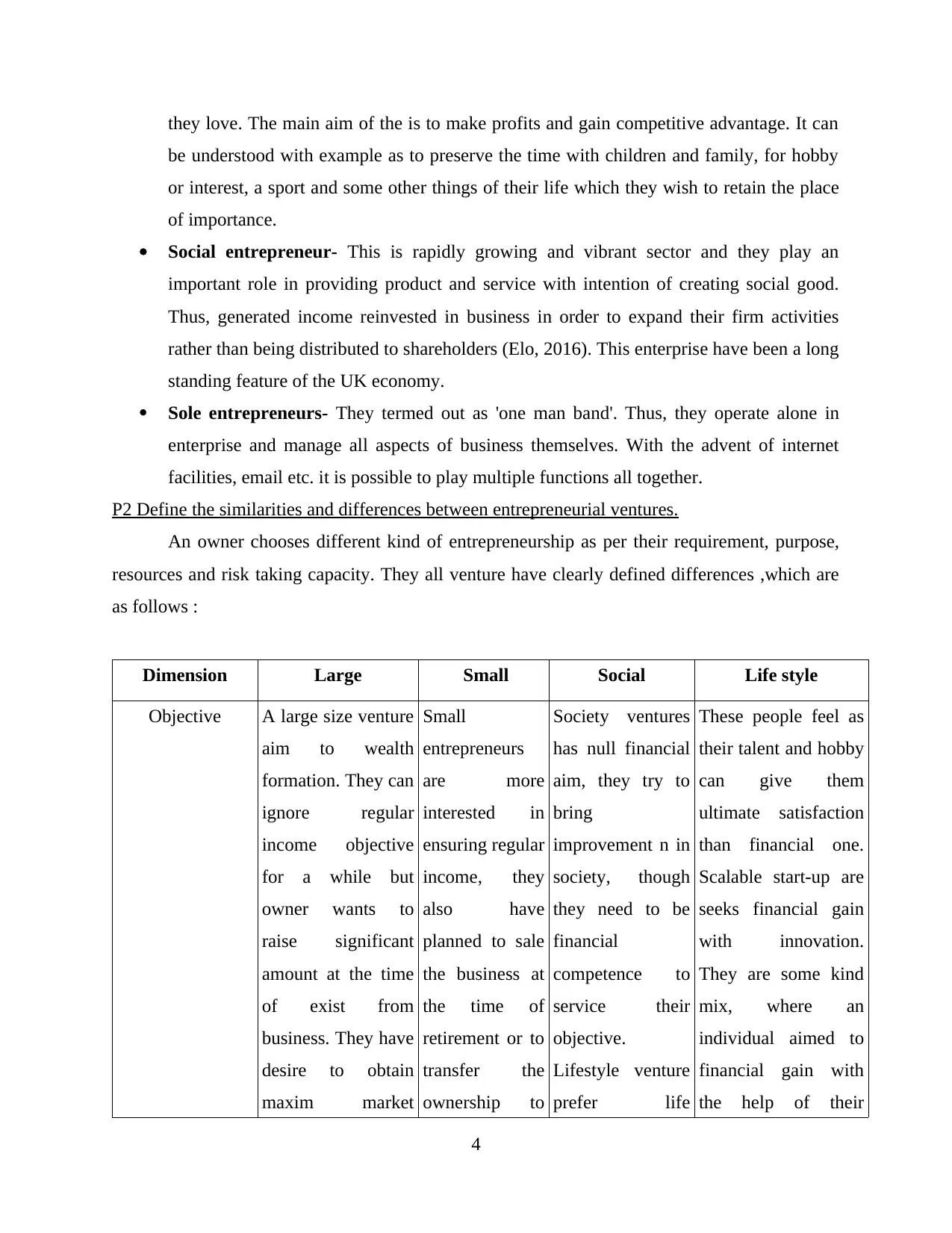
they love. The main aim of the is to make profits and gain competitive advantage. It can
be understood with example as to preserve the time with children and family, for hobby
or interest, a sport and some other things of their life which they wish to retain the place
of importance.
Social entrepreneur- This is rapidly growing and vibrant sector and they play an
important role in providing product and service with intention of creating social good.
Thus, generated income reinvested in business in order to expand their firm activities
rather than being distributed to shareholders (Elo, 2016). This enterprise have been a long
standing feature of the UK economy.
Sole entrepreneurs- They termed out as 'one man band'. Thus, they operate alone in
enterprise and manage all aspects of business themselves. With the advent of internet
facilities, email etc. it is possible to play multiple functions all together.
P2 Define the similarities and differences between entrepreneurial ventures.
An owner chooses different kind of entrepreneurship as per their requirement, purpose,
resources and risk taking capacity. They all venture have clearly defined differences ,which are
as follows :
Dimension Large Small Social Life style
Objective A large size venture
aim to wealth
formation. They can
ignore regular
income objective
for a while but
owner wants to
raise significant
amount at the time
of exist from
business. They have
desire to obtain
maxim market
Small
entrepreneurs
are more
interested in
ensuring regular
income, they
also have
planned to sale
the business at
the time of
retirement or to
transfer the
ownership to
Society ventures
has null financial
aim, they try to
bring
improvement n in
society, though
they need to be
financial
competence to
service their
objective.
Lifestyle venture
prefer life
These people feel as
their talent and hobby
can give them
ultimate satisfaction
than financial one.
Scalable start-up are
seeks financial gain
with innovation.
They are some kind
mix, where an
individual aimed to
financial gain with
the help of their
4
be understood with example as to preserve the time with children and family, for hobby
or interest, a sport and some other things of their life which they wish to retain the place
of importance.
Social entrepreneur- This is rapidly growing and vibrant sector and they play an
important role in providing product and service with intention of creating social good.
Thus, generated income reinvested in business in order to expand their firm activities
rather than being distributed to shareholders (Elo, 2016). This enterprise have been a long
standing feature of the UK economy.
Sole entrepreneurs- They termed out as 'one man band'. Thus, they operate alone in
enterprise and manage all aspects of business themselves. With the advent of internet
facilities, email etc. it is possible to play multiple functions all together.
P2 Define the similarities and differences between entrepreneurial ventures.
An owner chooses different kind of entrepreneurship as per their requirement, purpose,
resources and risk taking capacity. They all venture have clearly defined differences ,which are
as follows :
Dimension Large Small Social Life style
Objective A large size venture
aim to wealth
formation. They can
ignore regular
income objective
for a while but
owner wants to
raise significant
amount at the time
of exist from
business. They have
desire to obtain
maxim market
Small
entrepreneurs
are more
interested in
ensuring regular
income, they
also have
planned to sale
the business at
the time of
retirement or to
transfer the
ownership to
Society ventures
has null financial
aim, they try to
bring
improvement n in
society, though
they need to be
financial
competence to
service their
objective.
Lifestyle venture
prefer life
These people feel as
their talent and hobby
can give them
ultimate satisfaction
than financial one.
Scalable start-up are
seeks financial gain
with innovation.
They are some kind
mix, where an
individual aimed to
financial gain with
the help of their
4
⊘ This is a preview!⊘
Do you want full access?
Subscribe today to unlock all pages.

Trusted by 1+ million students worldwide
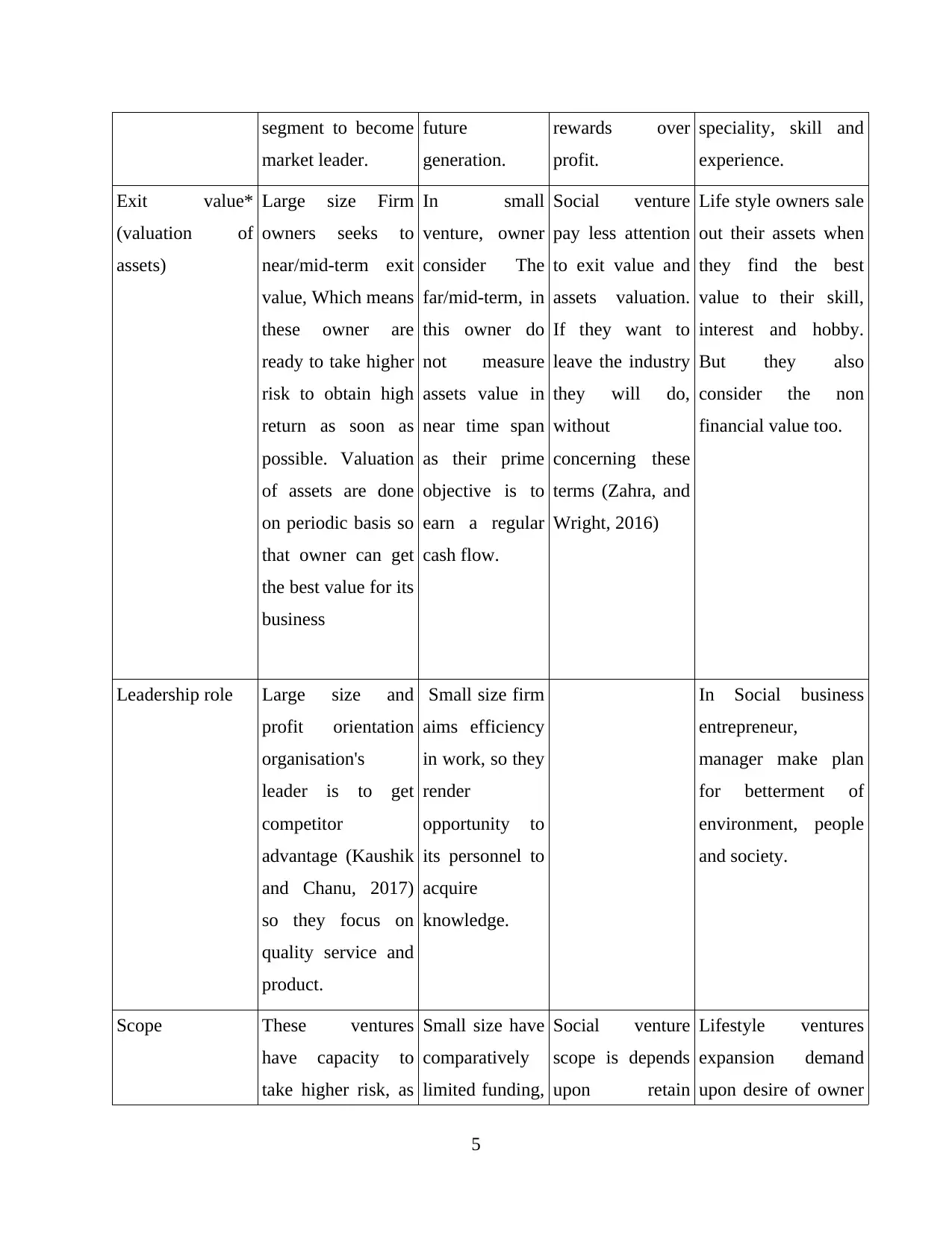
segment to become
market leader.
future
generation.
rewards over
profit.
speciality, skill and
experience.
Exit value*
(valuation of
assets)
Large size Firm
owners seeks to
near/mid-term exit
value, Which means
these owner are
ready to take higher
risk to obtain high
return as soon as
possible. Valuation
of assets are done
on periodic basis so
that owner can get
the best value for its
business
In small
venture, owner
consider The
far/mid-term, in
this owner do
not measure
assets value in
near time span
as their prime
objective is to
earn a regular
cash flow.
Social venture
pay less attention
to exit value and
assets valuation.
If they want to
leave the industry
they will do,
without
concerning these
terms (Zahra, and
Wright, 2016)
Life style owners sale
out their assets when
they find the best
value to their skill,
interest and hobby.
But they also
consider the non
financial value too.
Leadership role Large size and
profit orientation
organisation's
leader is to get
competitor
advantage (Kaushik
and Chanu, 2017)
so they focus on
quality service and
product.
Small size firm
aims efficiency
in work, so they
render
opportunity to
its personnel to
acquire
knowledge.
In Social business
entrepreneur,
manager make plan
for betterment of
environment, people
and society.
Scope These ventures
have capacity to
take higher risk, as
Small size have
comparatively
limited funding,
Social venture
scope is depends
upon retain
Lifestyle ventures
expansion demand
upon desire of owner
5
market leader.
future
generation.
rewards over
profit.
speciality, skill and
experience.
Exit value*
(valuation of
assets)
Large size Firm
owners seeks to
near/mid-term exit
value, Which means
these owner are
ready to take higher
risk to obtain high
return as soon as
possible. Valuation
of assets are done
on periodic basis so
that owner can get
the best value for its
business
In small
venture, owner
consider The
far/mid-term, in
this owner do
not measure
assets value in
near time span
as their prime
objective is to
earn a regular
cash flow.
Social venture
pay less attention
to exit value and
assets valuation.
If they want to
leave the industry
they will do,
without
concerning these
terms (Zahra, and
Wright, 2016)
Life style owners sale
out their assets when
they find the best
value to their skill,
interest and hobby.
But they also
consider the non
financial value too.
Leadership role Large size and
profit orientation
organisation's
leader is to get
competitor
advantage (Kaushik
and Chanu, 2017)
so they focus on
quality service and
product.
Small size firm
aims efficiency
in work, so they
render
opportunity to
its personnel to
acquire
knowledge.
In Social business
entrepreneur,
manager make plan
for betterment of
environment, people
and society.
Scope These ventures
have capacity to
take higher risk, as
Small size have
comparatively
limited funding,
Social venture
scope is depends
upon retain
Lifestyle ventures
expansion demand
upon desire of owner
5
Paraphrase This Document
Need a fresh take? Get an instant paraphrase of this document with our AI Paraphraser
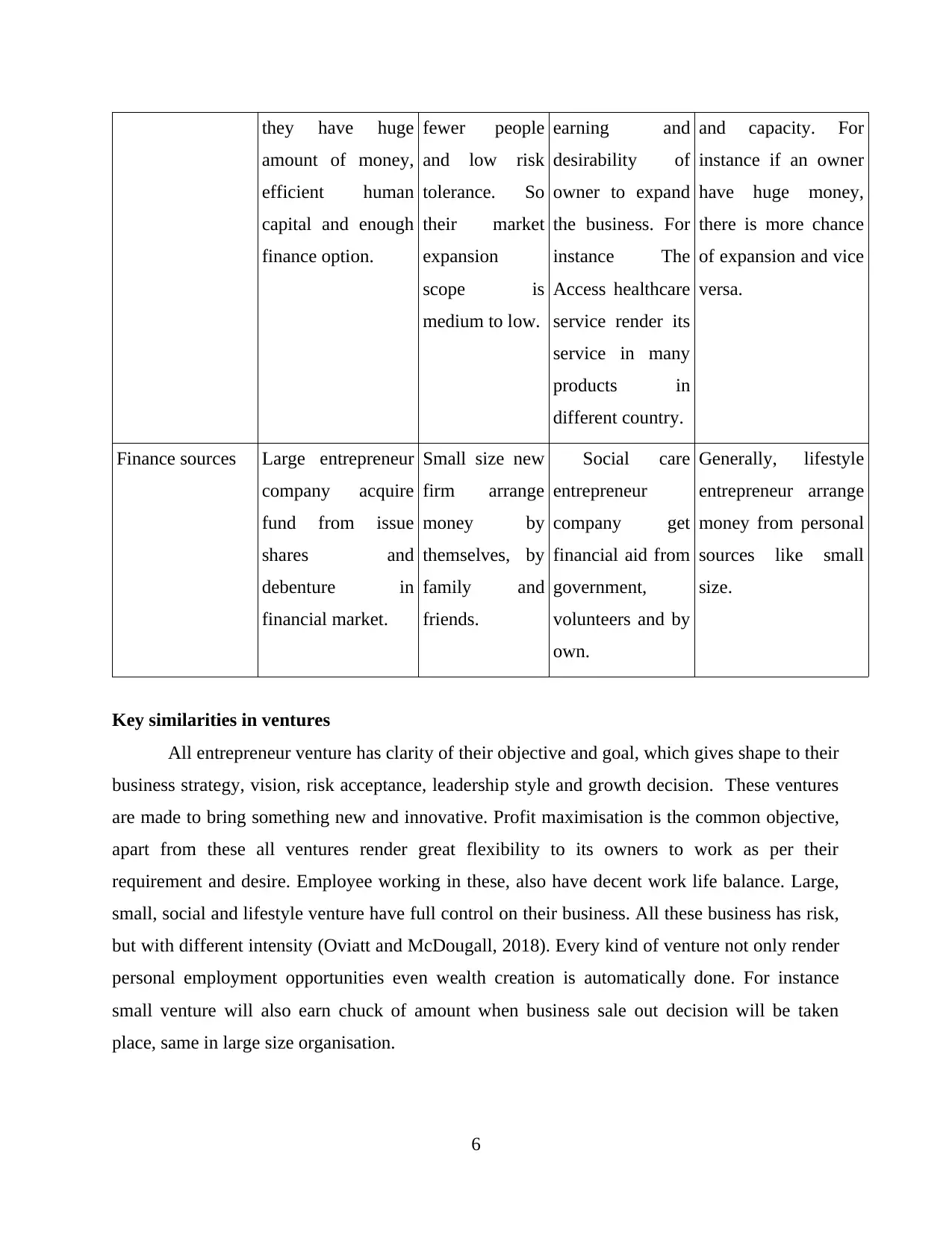
they have huge
amount of money,
efficient human
capital and enough
finance option.
fewer people
and low risk
tolerance. So
their market
expansion
scope is
medium to low.
earning and
desirability of
owner to expand
the business. For
instance The
Access healthcare
service render its
service in many
products in
different country.
and capacity. For
instance if an owner
have huge money,
there is more chance
of expansion and vice
versa.
Finance sources Large entrepreneur
company acquire
fund from issue
shares and
debenture in
financial market.
Small size new
firm arrange
money by
themselves, by
family and
friends.
Social care
entrepreneur
company get
financial aid from
government,
volunteers and by
own.
Generally, lifestyle
entrepreneur arrange
money from personal
sources like small
size.
Key similarities in ventures
All entrepreneur venture has clarity of their objective and goal, which gives shape to their
business strategy, vision, risk acceptance, leadership style and growth decision. These ventures
are made to bring something new and innovative. Profit maximisation is the common objective,
apart from these all ventures render great flexibility to its owners to work as per their
requirement and desire. Employee working in these, also have decent work life balance. Large,
small, social and lifestyle venture have full control on their business. All these business has risk,
but with different intensity (Oviatt and McDougall, 2018). Every kind of venture not only render
personal employment opportunities even wealth creation is automatically done. For instance
small venture will also earn chuck of amount when business sale out decision will be taken
place, same in large size organisation.
6
amount of money,
efficient human
capital and enough
finance option.
fewer people
and low risk
tolerance. So
their market
expansion
scope is
medium to low.
earning and
desirability of
owner to expand
the business. For
instance The
Access healthcare
service render its
service in many
products in
different country.
and capacity. For
instance if an owner
have huge money,
there is more chance
of expansion and vice
versa.
Finance sources Large entrepreneur
company acquire
fund from issue
shares and
debenture in
financial market.
Small size new
firm arrange
money by
themselves, by
family and
friends.
Social care
entrepreneur
company get
financial aid from
government,
volunteers and by
own.
Generally, lifestyle
entrepreneur arrange
money from personal
sources like small
size.
Key similarities in ventures
All entrepreneur venture has clarity of their objective and goal, which gives shape to their
business strategy, vision, risk acceptance, leadership style and growth decision. These ventures
are made to bring something new and innovative. Profit maximisation is the common objective,
apart from these all ventures render great flexibility to its owners to work as per their
requirement and desire. Employee working in these, also have decent work life balance. Large,
small, social and lifestyle venture have full control on their business. All these business has risk,
but with different intensity (Oviatt and McDougall, 2018). Every kind of venture not only render
personal employment opportunities even wealth creation is automatically done. For instance
small venture will also earn chuck of amount when business sale out decision will be taken
place, same in large size organisation.
6
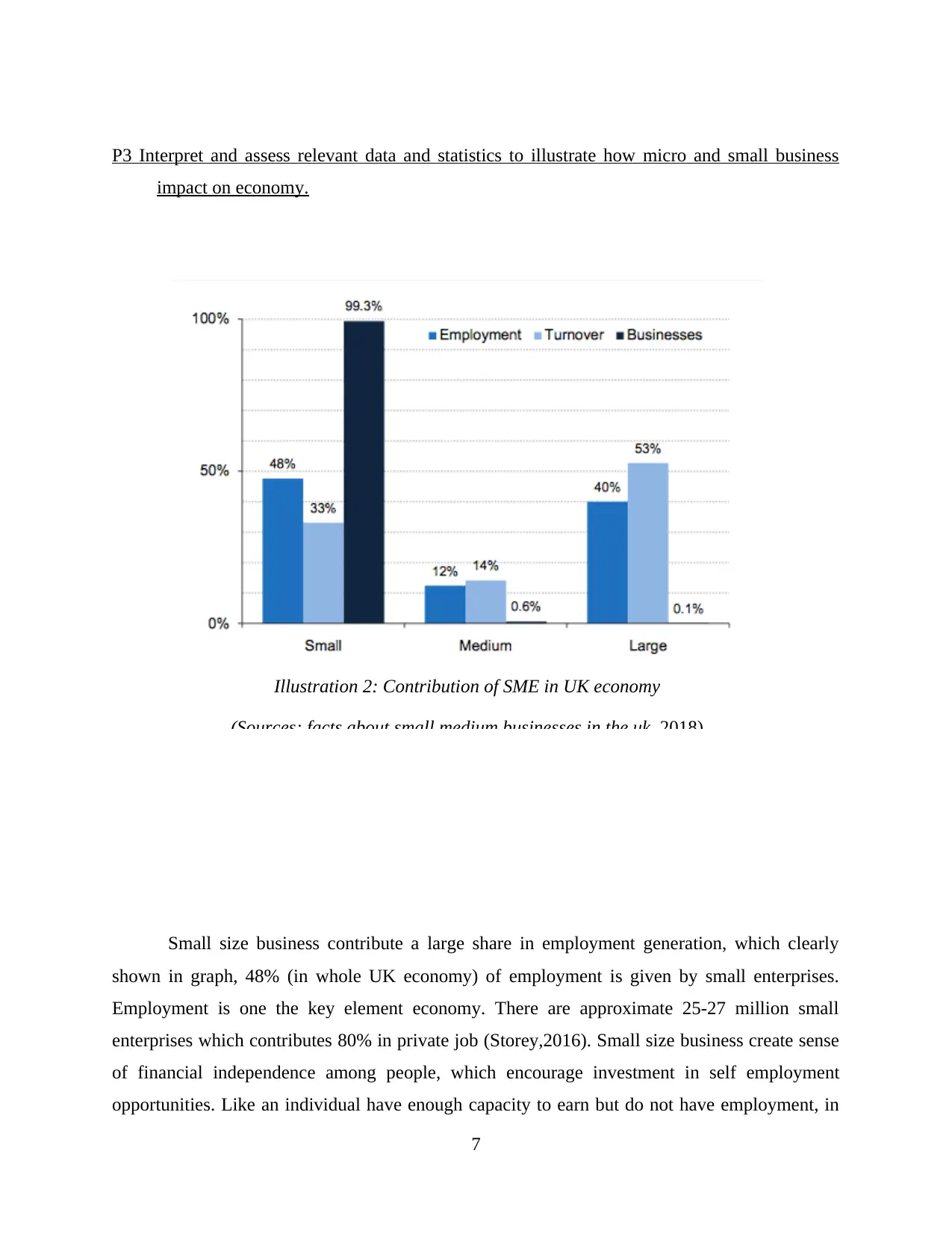
P3 Interpret and assess relevant data and statistics to illustrate how micro and small business
impact on economy.
Small size business contribute a large share in employment generation, which clearly
shown in graph, 48% (in whole UK economy) of employment is given by small enterprises.
Employment is one the key element economy. There are approximate 25-27 million small
enterprises which contributes 80% in private job (Storey,2016). Small size business create sense
of financial independence among people, which encourage investment in self employment
opportunities. Like an individual have enough capacity to earn but do not have employment, in
7
Illustration 2: Contribution of SME in UK economy
(Sources: facts about small medium businesses in the uk, 2018)
impact on economy.
Small size business contribute a large share in employment generation, which clearly
shown in graph, 48% (in whole UK economy) of employment is given by small enterprises.
Employment is one the key element economy. There are approximate 25-27 million small
enterprises which contributes 80% in private job (Storey,2016). Small size business create sense
of financial independence among people, which encourage investment in self employment
opportunities. Like an individual have enough capacity to earn but do not have employment, in
7
Illustration 2: Contribution of SME in UK economy
(Sources: facts about small medium businesses in the uk, 2018)
⊘ This is a preview!⊘
Do you want full access?
Subscribe today to unlock all pages.

Trusted by 1+ million students worldwide
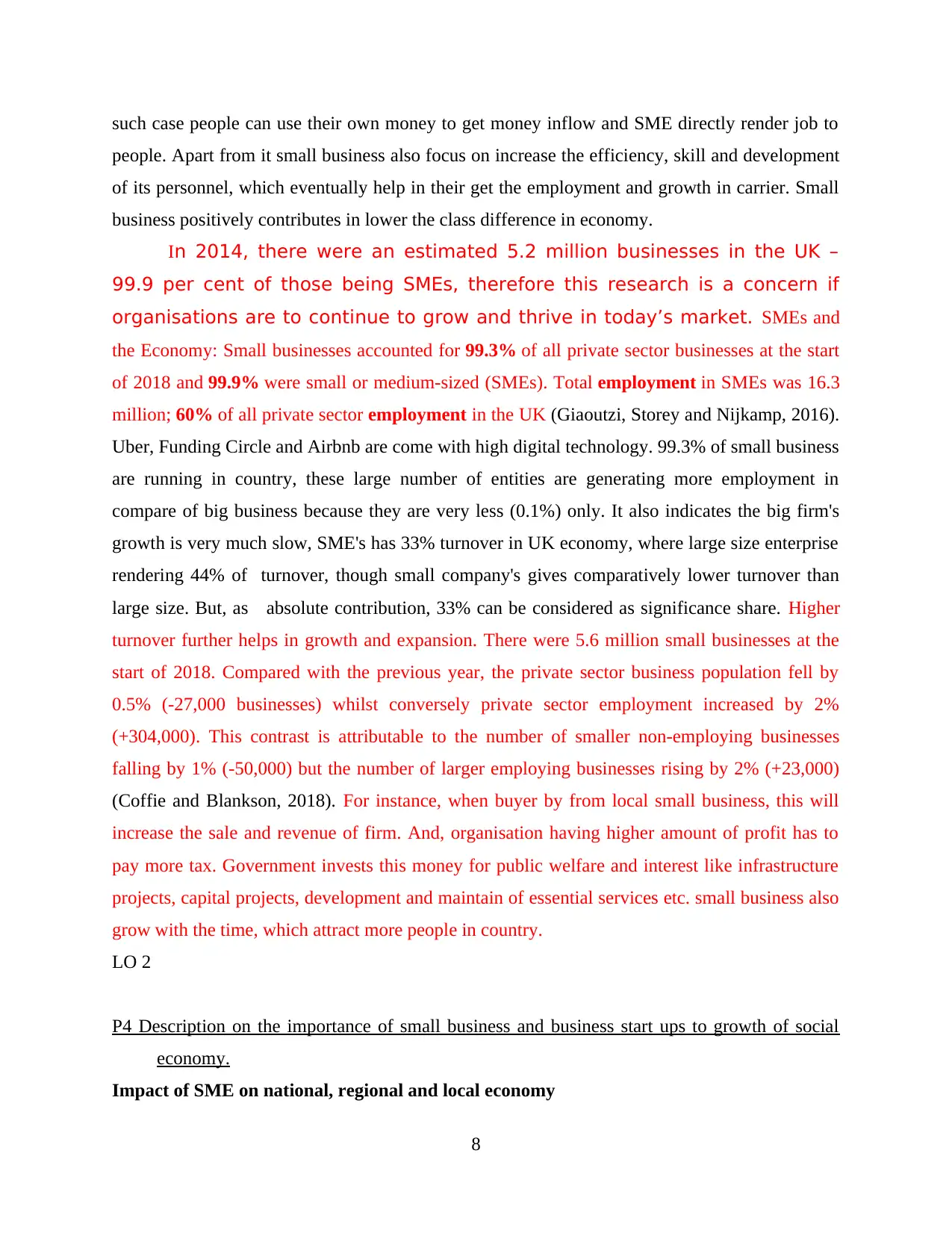
such case people can use their own money to get money inflow and SME directly render job to
people. Apart from it small business also focus on increase the efficiency, skill and development
of its personnel, which eventually help in their get the employment and growth in carrier. Small
business positively contributes in lower the class difference in economy.
In 2014, there were an estimated 5.2 million businesses in the UK –
99.9 per cent of those being SMEs, therefore this research is a concern if
organisations are to continue to grow and thrive in today’s market. SMEs and
the Economy: Small businesses accounted for 99.3% of all private sector businesses at the start
of 2018 and 99.9% were small or medium-sized (SMEs). Total employment in SMEs was 16.3
million; 60% of all private sector employment in the UK (Giaoutzi, Storey and Nijkamp, 2016).
Uber, Funding Circle and Airbnb are come with high digital technology. 99.3% of small business
are running in country, these large number of entities are generating more employment in
compare of big business because they are very less (0.1%) only. It also indicates the big firm's
growth is very much slow, SME's has 33% turnover in UK economy, where large size enterprise
rendering 44% of turnover, though small company's gives comparatively lower turnover than
large size. But, as absolute contribution, 33% can be considered as significance share. Higher
turnover further helps in growth and expansion. There were 5.6 million small businesses at the
start of 2018. Compared with the previous year, the private sector business population fell by
0.5% (-27,000 businesses) whilst conversely private sector employment increased by 2%
(+304,000). This contrast is attributable to the number of smaller non-employing businesses
falling by 1% (-50,000) but the number of larger employing businesses rising by 2% (+23,000)
(Coffie and Blankson, 2018). For instance, when buyer by from local small business, this will
increase the sale and revenue of firm. And, organisation having higher amount of profit has to
pay more tax. Government invests this money for public welfare and interest like infrastructure
projects, capital projects, development and maintain of essential services etc. small business also
grow with the time, which attract more people in country.
LO 2
P4 Description on the importance of small business and business start ups to growth of social
economy.
Impact of SME on national, regional and local economy
8
people. Apart from it small business also focus on increase the efficiency, skill and development
of its personnel, which eventually help in their get the employment and growth in carrier. Small
business positively contributes in lower the class difference in economy.
In 2014, there were an estimated 5.2 million businesses in the UK –
99.9 per cent of those being SMEs, therefore this research is a concern if
organisations are to continue to grow and thrive in today’s market. SMEs and
the Economy: Small businesses accounted for 99.3% of all private sector businesses at the start
of 2018 and 99.9% were small or medium-sized (SMEs). Total employment in SMEs was 16.3
million; 60% of all private sector employment in the UK (Giaoutzi, Storey and Nijkamp, 2016).
Uber, Funding Circle and Airbnb are come with high digital technology. 99.3% of small business
are running in country, these large number of entities are generating more employment in
compare of big business because they are very less (0.1%) only. It also indicates the big firm's
growth is very much slow, SME's has 33% turnover in UK economy, where large size enterprise
rendering 44% of turnover, though small company's gives comparatively lower turnover than
large size. But, as absolute contribution, 33% can be considered as significance share. Higher
turnover further helps in growth and expansion. There were 5.6 million small businesses at the
start of 2018. Compared with the previous year, the private sector business population fell by
0.5% (-27,000 businesses) whilst conversely private sector employment increased by 2%
(+304,000). This contrast is attributable to the number of smaller non-employing businesses
falling by 1% (-50,000) but the number of larger employing businesses rising by 2% (+23,000)
(Coffie and Blankson, 2018). For instance, when buyer by from local small business, this will
increase the sale and revenue of firm. And, organisation having higher amount of profit has to
pay more tax. Government invests this money for public welfare and interest like infrastructure
projects, capital projects, development and maintain of essential services etc. small business also
grow with the time, which attract more people in country.
LO 2
P4 Description on the importance of small business and business start ups to growth of social
economy.
Impact of SME on national, regional and local economy
8
Paraphrase This Document
Need a fresh take? Get an instant paraphrase of this document with our AI Paraphraser
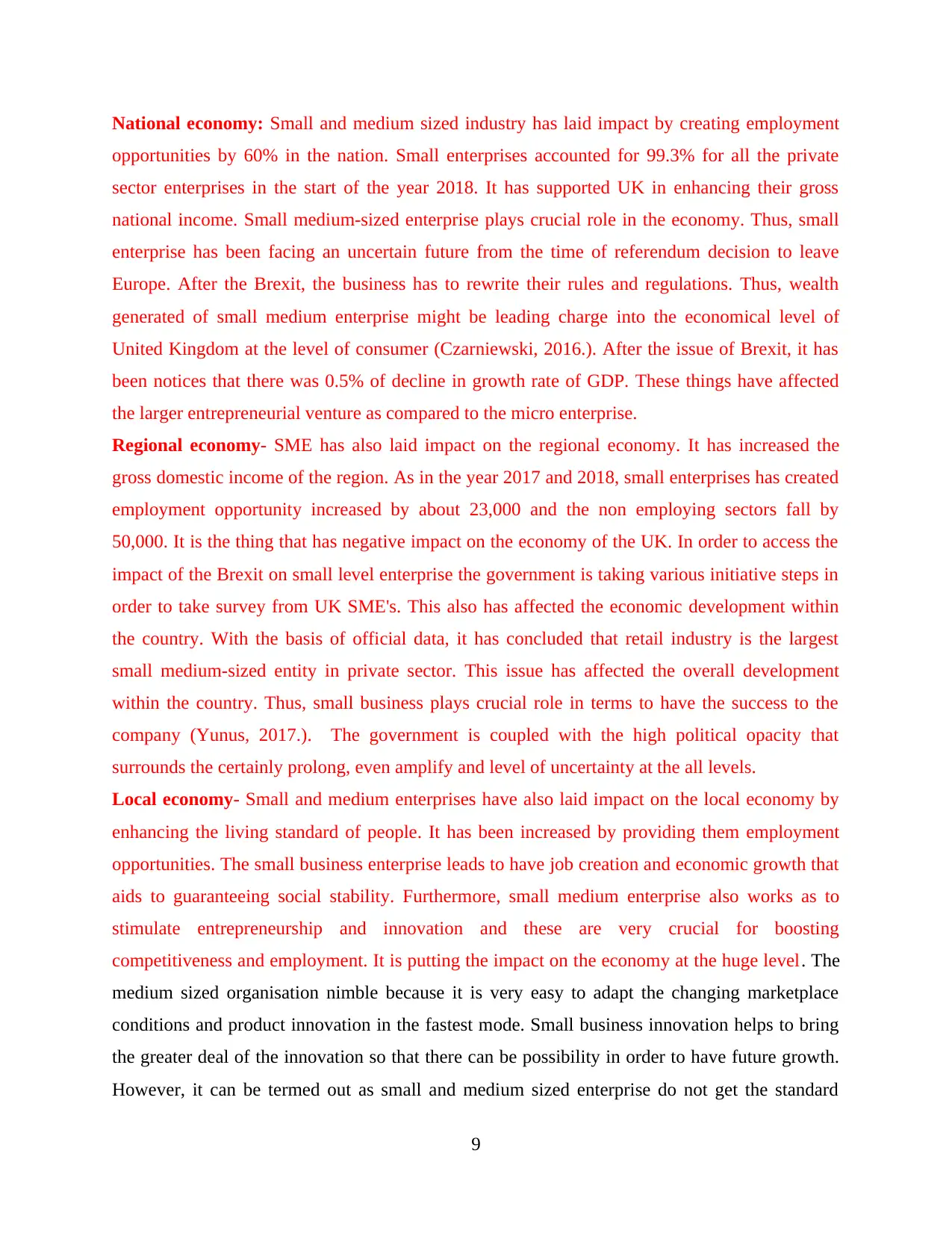
National economy: Small and medium sized industry has laid impact by creating employment
opportunities by 60% in the nation. Small enterprises accounted for 99.3% for all the private
sector enterprises in the start of the year 2018. It has supported UK in enhancing their gross
national income. Small medium-sized enterprise plays crucial role in the economy. Thus, small
enterprise has been facing an uncertain future from the time of referendum decision to leave
Europe. After the Brexit, the business has to rewrite their rules and regulations. Thus, wealth
generated of small medium enterprise might be leading charge into the economical level of
United Kingdom at the level of consumer (Czarniewski, 2016.). After the issue of Brexit, it has
been notices that there was 0.5% of decline in growth rate of GDP. These things have affected
the larger entrepreneurial venture as compared to the micro enterprise.
Regional economy- SME has also laid impact on the regional economy. It has increased the
gross domestic income of the region. As in the year 2017 and 2018, small enterprises has created
employment opportunity increased by about 23,000 and the non employing sectors fall by
50,000. It is the thing that has negative impact on the economy of the UK. In order to access the
impact of the Brexit on small level enterprise the government is taking various initiative steps in
order to take survey from UK SME's. This also has affected the economic development within
the country. With the basis of official data, it has concluded that retail industry is the largest
small medium-sized entity in private sector. This issue has affected the overall development
within the country. Thus, small business plays crucial role in terms to have the success to the
company (Yunus, 2017.). The government is coupled with the high political opacity that
surrounds the certainly prolong, even amplify and level of uncertainty at the all levels.
Local economy- Small and medium enterprises have also laid impact on the local economy by
enhancing the living standard of people. It has been increased by providing them employment
opportunities. The small business enterprise leads to have job creation and economic growth that
aids to guaranteeing social stability. Furthermore, small medium enterprise also works as to
stimulate entrepreneurship and innovation and these are very crucial for boosting
competitiveness and employment. It is putting the impact on the economy at the huge level. The
medium sized organisation nimble because it is very easy to adapt the changing marketplace
conditions and product innovation in the fastest mode. Small business innovation helps to bring
the greater deal of the innovation so that there can be possibility in order to have future growth.
However, it can be termed out as small and medium sized enterprise do not get the standard
9
opportunities by 60% in the nation. Small enterprises accounted for 99.3% for all the private
sector enterprises in the start of the year 2018. It has supported UK in enhancing their gross
national income. Small medium-sized enterprise plays crucial role in the economy. Thus, small
enterprise has been facing an uncertain future from the time of referendum decision to leave
Europe. After the Brexit, the business has to rewrite their rules and regulations. Thus, wealth
generated of small medium enterprise might be leading charge into the economical level of
United Kingdom at the level of consumer (Czarniewski, 2016.). After the issue of Brexit, it has
been notices that there was 0.5% of decline in growth rate of GDP. These things have affected
the larger entrepreneurial venture as compared to the micro enterprise.
Regional economy- SME has also laid impact on the regional economy. It has increased the
gross domestic income of the region. As in the year 2017 and 2018, small enterprises has created
employment opportunity increased by about 23,000 and the non employing sectors fall by
50,000. It is the thing that has negative impact on the economy of the UK. In order to access the
impact of the Brexit on small level enterprise the government is taking various initiative steps in
order to take survey from UK SME's. This also has affected the economic development within
the country. With the basis of official data, it has concluded that retail industry is the largest
small medium-sized entity in private sector. This issue has affected the overall development
within the country. Thus, small business plays crucial role in terms to have the success to the
company (Yunus, 2017.). The government is coupled with the high political opacity that
surrounds the certainly prolong, even amplify and level of uncertainty at the all levels.
Local economy- Small and medium enterprises have also laid impact on the local economy by
enhancing the living standard of people. It has been increased by providing them employment
opportunities. The small business enterprise leads to have job creation and economic growth that
aids to guaranteeing social stability. Furthermore, small medium enterprise also works as to
stimulate entrepreneurship and innovation and these are very crucial for boosting
competitiveness and employment. It is putting the impact on the economy at the huge level. The
medium sized organisation nimble because it is very easy to adapt the changing marketplace
conditions and product innovation in the fastest mode. Small business innovation helps to bring
the greater deal of the innovation so that there can be possibility in order to have future growth.
However, it can be termed out as small and medium sized enterprise do not get the standard
9
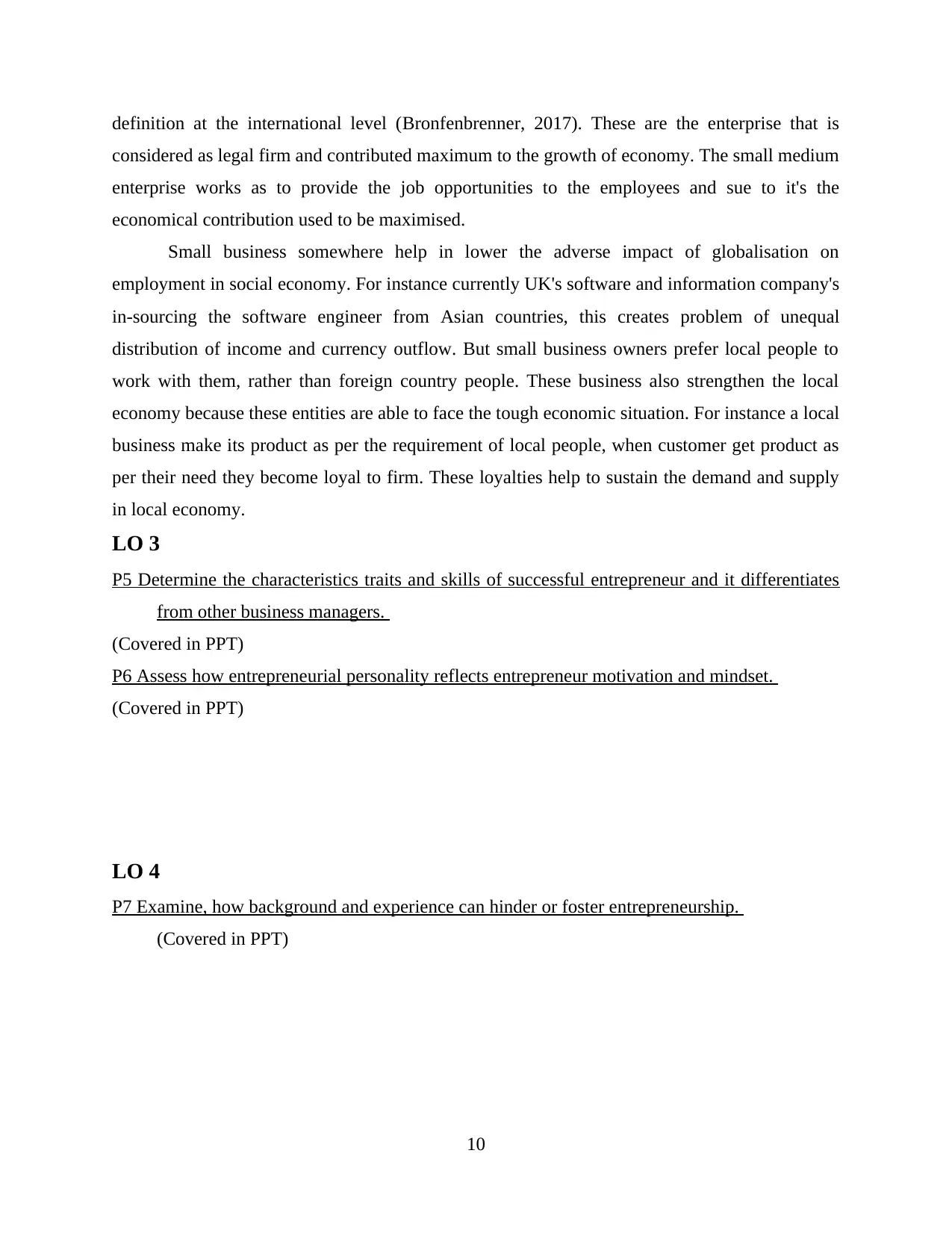
definition at the international level (Bronfenbrenner, 2017). These are the enterprise that is
considered as legal firm and contributed maximum to the growth of economy. The small medium
enterprise works as to provide the job opportunities to the employees and sue to it's the
economical contribution used to be maximised.
Small business somewhere help in lower the adverse impact of globalisation on
employment in social economy. For instance currently UK's software and information company's
in-sourcing the software engineer from Asian countries, this creates problem of unequal
distribution of income and currency outflow. But small business owners prefer local people to
work with them, rather than foreign country people. These business also strengthen the local
economy because these entities are able to face the tough economic situation. For instance a local
business make its product as per the requirement of local people, when customer get product as
per their need they become loyal to firm. These loyalties help to sustain the demand and supply
in local economy.
LO 3
P5 Determine the characteristics traits and skills of successful entrepreneur and it differentiates
from other business managers.
(Covered in PPT)
P6 Assess how entrepreneurial personality reflects entrepreneur motivation and mindset.
(Covered in PPT)
LO 4
P7 Examine, how background and experience can hinder or foster entrepreneurship.
(Covered in PPT)
10
considered as legal firm and contributed maximum to the growth of economy. The small medium
enterprise works as to provide the job opportunities to the employees and sue to it's the
economical contribution used to be maximised.
Small business somewhere help in lower the adverse impact of globalisation on
employment in social economy. For instance currently UK's software and information company's
in-sourcing the software engineer from Asian countries, this creates problem of unequal
distribution of income and currency outflow. But small business owners prefer local people to
work with them, rather than foreign country people. These business also strengthen the local
economy because these entities are able to face the tough economic situation. For instance a local
business make its product as per the requirement of local people, when customer get product as
per their need they become loyal to firm. These loyalties help to sustain the demand and supply
in local economy.
LO 3
P5 Determine the characteristics traits and skills of successful entrepreneur and it differentiates
from other business managers.
(Covered in PPT)
P6 Assess how entrepreneurial personality reflects entrepreneur motivation and mindset.
(Covered in PPT)
LO 4
P7 Examine, how background and experience can hinder or foster entrepreneurship.
(Covered in PPT)
10
⊘ This is a preview!⊘
Do you want full access?
Subscribe today to unlock all pages.

Trusted by 1+ million students worldwide
1 out of 18
Related Documents
Your All-in-One AI-Powered Toolkit for Academic Success.
+13062052269
info@desklib.com
Available 24*7 on WhatsApp / Email
![[object Object]](/_next/static/media/star-bottom.7253800d.svg)
Unlock your academic potential
Copyright © 2020–2025 A2Z Services. All Rights Reserved. Developed and managed by ZUCOL.





